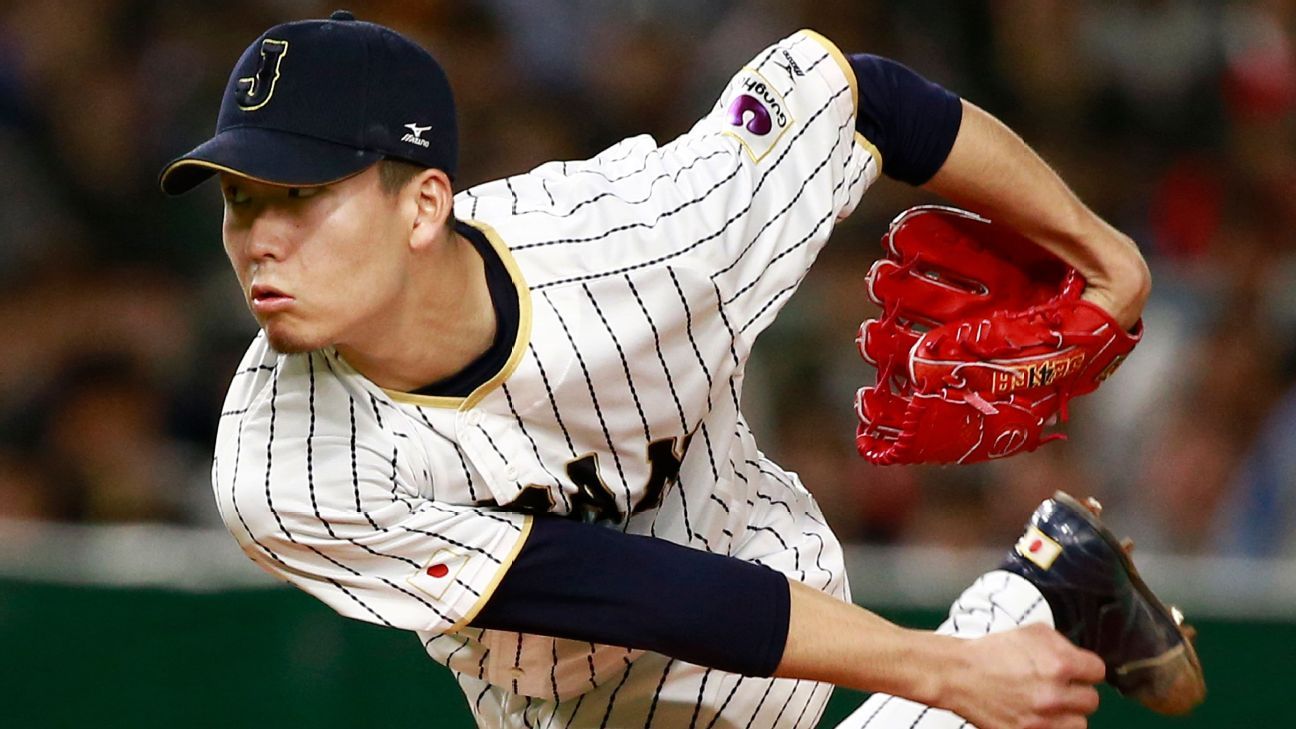Every year, Macy’s unveils its elaborate window displays for the holiday season. Many people walk by and admire the sights. Some enter to fight the crowds, hoping to find that perfect gift. Steve Cohen? He would probably just purchase the whole dang store.
The New York Mets‘ owner has added to his team’s offseason spending spree, agreeing to a five-year, $75 million deal with pitcher Kodai Senga, who is viewed as one of the best starting pitchers in Japan. The 29-year-old right-hander posted a 1.94 ERA with 156 strikeouts in 144 innings, allowing just 104 hits. Senga has a big fastball that reaches the upper 90s and a splitter referred to as a “ghost forkball,” because — wait for it — it disappears.
His breaking stuff is considered just OK, and his command can be a little shaky, as he averaged 3.1 walks allowed per nine innings last season, but given the overall quality of his stuff and the success other top Japanese pitchers have had coming over to the majors, he projects at least as a solid midrotation starter with perhaps even more upside than that.
I like this signing as one of the best of the offseason, especially considering the similar contracts for starting pitchers such as Taijuan Walker (four years, $72 million) and Jameson Taillon (four years, $68 million) who don’t have Senga’s upside. Sure, he’s not a lock to get there, but Hisashi Iwakuma and Kenta Maeda also came to the majors from Japan with a splitter as a primary piece of their arsenals and have had success. Senga has better velocity than those two. Shohei Ohtani mixes a high-octane fastball with a splitter, and batters have hit .104 against Ohtani’s splitter the past two seasons, so the ghost forkball has a chance to be a huge weapon for Senga.
As for the Mets, let’s recap their offseason signings:
-
Re-signed Brandon Nimmo (8 years, $162 million, $20.25M AAV)
-
Re-signed Edwin Diaz (5 years, $102 million, $18.6 million AAV)
-
Signed Justin Verlander (2 years, $86.667 million, $43.33 million AAV)
-
Signed Kodai Senga (5 years, $75 million, $15 million AAV)
-
Signed Jose Quintana (2 years, $26 million, $13 million AAV)
-
Signed David Robertson (1 year, $10 million)
Total: $461.667 million in future salaries. Sure, that feels extreme, and fans of small-market teams are understandably upset with baseball’s spending disparities, but keep in mind the Texas Rangers committed $500 million last offseason for just Corey Seager and Marcus Semien — plus $185 million this offseason for Jacob deGrom.
The Mets also acquired reliever Brooks Raley from the Rays, and he’ll make $5.75 million. All of this will almost put a dent in Cohen’s wallet. And in one sense, all the Mets really did was replace last year’s talent:
It’s certainly expensive to build a team via free agents, but the Mets had little choice but to go down this road this offseason if they hoped to contend again in 2023. While the Mets’ luxury tax payroll in 2022 ran nearly $288 million, the estimated 2023 luxury tax payroll is at $349.6 million, according to Roster Resource. The Mets are probably done with their big moves — although I could see them adding one more relief pitcher. At this point, why not?
Needless to say, the “Steve Cohen Tax” didn’t prevent the owner from spending. The new collective bargaining agreement signed last March included a new tax level that was immediately dubbed the Cohen Tax. “It’s better than a bridge being named after you,” the owner quipped at the time.
In the past, there had been three levels of tax thresholds. In the new CBA, a fourth level was added, which kicks in at $293 million for 2023 and comes with a 60% surcharge on the overage. So the Mets will be paying $34 in taxes just on the surcharge alone, plus the basic tax for going over the $233 million threshold that will push the total CBT bill to over $76 million. (Thank your owner, Mets fans.)
Adding Senga does give the Mets’ enviable rotation depth that could allow Buck Showalter to deploy a six-man rotation, a good way to limit the innings for Verlander and Max Scherzer as they enter their age-40 and age-38 seasons. Remember, deGrom made just 11 starts in 2022 and Scherzer made just 23, so the Mets’ best hope for beating their 101 wins of last season is getting more starts from Verlander and Scherzer this season than they did from deGrom and Scherzer last season.
With Verlander, Scherzer, Quintana, Senga, Carlos Carrasco, David Peterson and Tylor Megill, the Mets have seven strong starting-pitcher options. The bullpen is a little thin behind Diaz, Robertson, Raley and Drew Smith, although Megill could be used as a multi-inning power arm if he’s not starting.
The Mets also have two positions that project as offensive upgrades. Their DHs hit just .222/.312/.375 last season, so a full season of Daniel Vogelbach as the left-handed platoon will help there. Their catchers hit just .217/.264/.306, so adding rookie Francisco Alvarez to the mix, even in a part-time role, should help some. (Alvarez could also end up as the short side of the platoon with Vogelbach.)
All that could add up to another 100-win season — especially if Verlander and Scherzer can stay healthy and Senga is the real deal. And it still may not be enough to wrestle the NL East title away from the Braves … not to mention the defending NL champion Phillies also looking to win their first division title since 2011.
